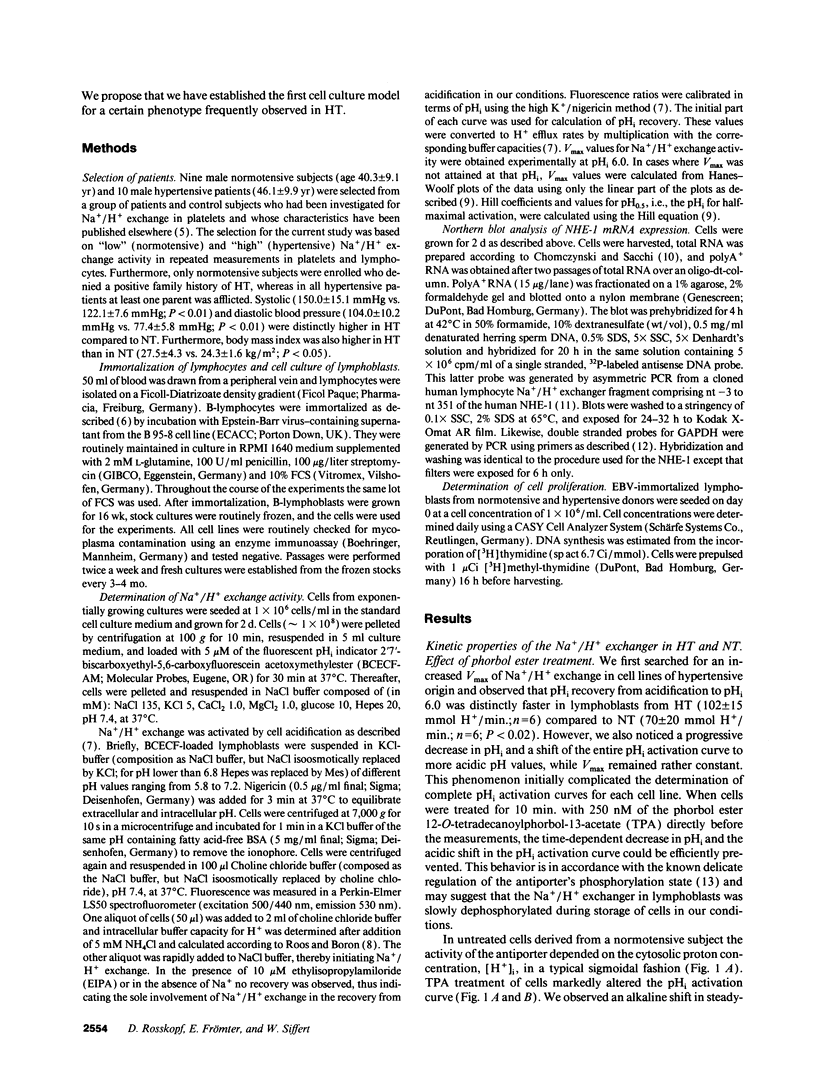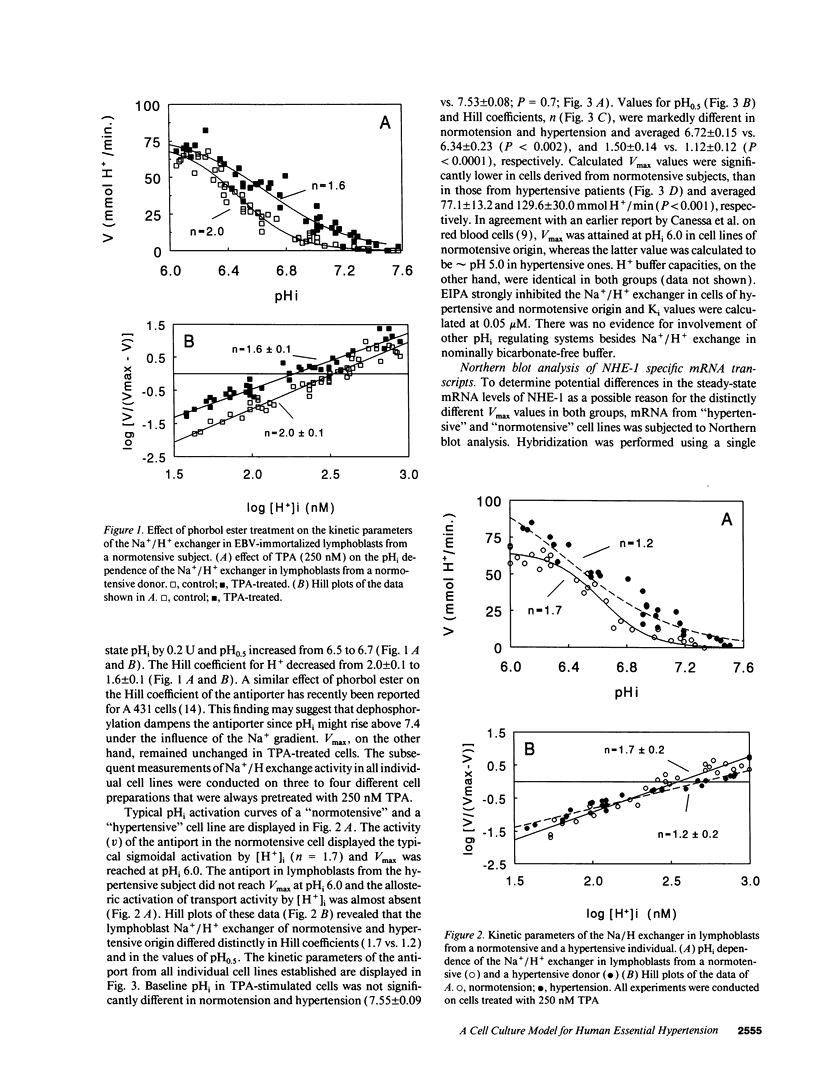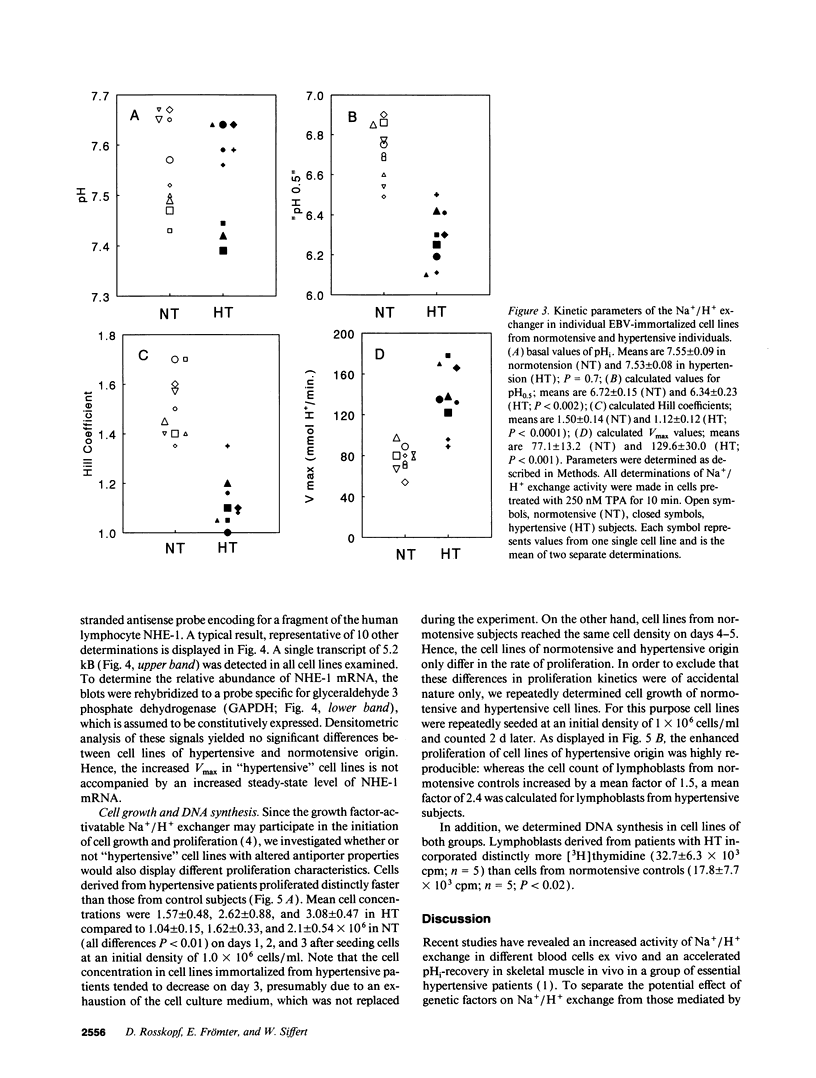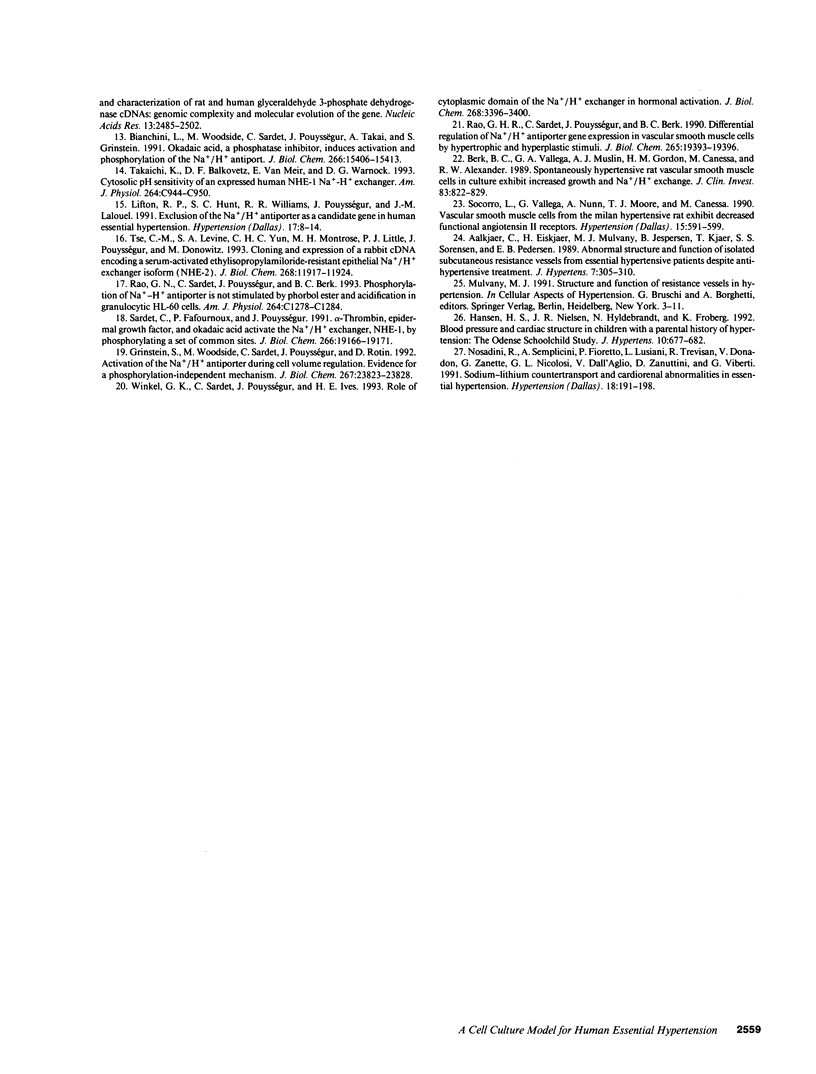Abstract
An enhancement of sodium-proton exchange activity is a frequently observed ion transport abnormality in essential hypertension. The cellular basis for this has not yet been elucidated. Due to the lack of a specific cell culture system it has been impossible to distinguish between intrinsic cellular abnormalities and influences exerted by the hypertensive neurohumoral milieu. Using Epstein-Barr virus we have immortalized lymphocytes from controls and from patients with essential hypertension that exhibited enhanced sodium-proton exchanger activity. Sodium-proton exchanger activity was determined in cells loaded with the fluorescent cytosolic pH indicator 2'7'-biscarboxyethyl-5,6-carboxyfluorescein acetoxymethylester (BCECF) after pretreatment with 250 nM of the phorbol ester 12-O-tetradecanoylphorbol-13-acetate for 10 min. Cell lines from hypertensive patients displayed higher Vmax values of sodium-proton exchange than those from normotensive controls (129.6 +/- 30.0 vs. 77.1 +/- 13.2 mmol H+/min.; P < 0.001). Hill coefficients for H+ were distinctly lower in hypertension compared to normotension (1.12 +/- 0.12 vs. 1.50 +/- 0.14; P < 0.0001). The enhanced antiporter activity in cell lines from hypertensive patients was not accompanied by a corresponding increase in steady-state NHE-1 mRNA transcript levels, which argues against overexpression of antiporter protein in hypertension. The cells from hypertensive patients with high sodium-proton exchange activity proliferated distinctly faster than those from normotensive controls. These human cell lines represent a novel model to study the mutual interaction between sodium-proton exchange and cell proliferation, and may provide insights into the alterations in ion transport observed in a group of patients with essential hypertension.
Full text
PDF






Images in this article
Selected References
These references are in PubMed. This may not be the complete list of references from this article.
- Aalkjaer C., Eiskjaer H., Mulvany M. J., Jespersen B., Kjaer T., Sørensen S. S., Pedersen E. B. Abnormal structure and function of isolated subcutaneous resistance vessels from essential hypertensive patients despite antihypertensive treatment. J Hypertens. 1989 Apr;7(4):305–310. [PubMed] [Google Scholar]
- Berk B. C., Vallega G., Muslin A. J., Gordon H. M., Canessa M., Alexander R. W. Spontaneously hypertensive rat vascular smooth muscle cells in culture exhibit increased growth and Na+/H+ exchange. J Clin Invest. 1989 Mar;83(3):822–829. doi: 10.1172/JCI113964. [DOI] [PMC free article] [PubMed] [Google Scholar]
- Bianchini L., Woodside M., Sardet C., Pouyssegur J., Takai A., Grinstein S. Okadaic acid, a phosphatase inhibitor, induces activation and phosphorylation of the Na+/H+ antiport. J Biol Chem. 1991 Aug 15;266(23):15406–15413. [PubMed] [Google Scholar]
- Canessa M., Morgan K., Goldszer R., Moore T. J., Spalvins A. Kinetic abnormalities of the red blood cell sodium-proton exchange in hypertensive patients. Hypertension. 1991 Mar;17(3):340–348. doi: 10.1161/01.hyp.17.3.340. [DOI] [PubMed] [Google Scholar]
- Chomczynski P., Sacchi N. Single-step method of RNA isolation by acid guanidinium thiocyanate-phenol-chloroform extraction. Anal Biochem. 1987 Apr;162(1):156–159. doi: 10.1006/abio.1987.9999. [DOI] [PubMed] [Google Scholar]
- Counillon L., Pouyssegur J. Molecular biology and hormonal regulation of vertebrate Na+/H+ exchanger isoforms. Soc Gen Physiol Ser. 1993;48:169–185. [PubMed] [Google Scholar]
- Grinstein S., Rotin D., Mason M. J. Na+/H+ exchange and growth factor-induced cytosolic pH changes. Role in cellular proliferation. Biochim Biophys Acta. 1989 Jan 18;988(1):73–97. doi: 10.1016/0304-4157(89)90004-x. [DOI] [PubMed] [Google Scholar]
- Grinstein S., Woodside M., Sardet C., Pouyssegur J., Rotin D. Activation of the Na+/H+ antiporter during cell volume regulation. Evidence for a phosphorylation-independent mechanism. J Biol Chem. 1992 Nov 25;267(33):23823–23828. [PubMed] [Google Scholar]
- Hansen H. S., Nielsen J. R., Hyldebrandt N., Froberg K. Blood pressure and cardiac structure in children with a parental history of hypertension: the Odense Schoolchild Study. J Hypertens. 1992 Jul;10(7):677–682. [PubMed] [Google Scholar]
- Lifton R. P., Hunt S. C., Williams R. R., Pouysségur J., Lalouel J. M. Exclusion of the Na(+)-H+ antiporter as a candidate gene in human essential hypertension. Hypertension. 1991 Jan;17(1):8–14. doi: 10.1161/01.hyp.17.1.8. [DOI] [PubMed] [Google Scholar]
- Nosadini R., Semplicini A., Fioretto P., Lusiani L., Trevisan R., Donadon V., Zanette G., Nicolosi G. L., Dall'Aglio V., Zanuttini D. Sodium-lithium countertransport and cardiorenal abnormalities in essential hypertension. Hypertension. 1991 Aug;18(2):191–198. doi: 10.1161/01.hyp.18.2.191. [DOI] [PubMed] [Google Scholar]
- Quednau B., Rosskopf D., Weiler-Güttler H., Siffert W. Detection of Na+/H+ exchanger mRNA in human neutrophils and lymphocytes using the polymerase chain reaction. FEBS Lett. 1991 Sep 9;289(2):221–223. doi: 10.1016/0014-5793(91)81074-i. [DOI] [PubMed] [Google Scholar]
- Rao G. N., Sardet C., Pouysségur J., Berk B. C. Differential regulation of Na+/H+ antiporter gene expression in vascular smooth muscle cells by hypertrophic and hyperplastic stimuli. J Biol Chem. 1990 Nov 15;265(32):19393–19396. [PubMed] [Google Scholar]
- Rao G. N., Sardet C., Pouysségur J., Berk B. C. Phosphorylation of Na(+)-H+ antiporter is not stimulated by phorbol ester and acidification in granulocytic HL-60 cells. Am J Physiol. 1993 May;264(5 Pt 1):C1278–C1284. doi: 10.1152/ajpcell.1993.264.5.C1278. [DOI] [PubMed] [Google Scholar]
- Roos A., Boron W. F. Intracellular pH. Physiol Rev. 1981 Apr;61(2):296–434. doi: 10.1152/physrev.1981.61.2.296. [DOI] [PubMed] [Google Scholar]
- Rosskopf D., Düsing R., Siffert W. Membrane sodium-proton exchange and primary hypertension. Hypertension. 1993 May;21(5):607–617. doi: 10.1161/01.hyp.21.5.607. [DOI] [PubMed] [Google Scholar]
- Rosskopf D., Siffert G., Osswald U., Witte K., Düsing R., Akkerman J. W., Siffert W. Platelet Na(+)-H+ exchanger activity in normotensive and hypertensive subjects: effect of enalapril therapy upon antiport activity. J Hypertens. 1992 Aug;10(8):839–847. [PubMed] [Google Scholar]
- Sardet C., Fafournoux P., Pouysségur J. Alpha-thrombin, epidermal growth factor, and okadaic acid activate the Na+/H+ exchanger, NHE-1, by phosphorylating a set of common sites. J Biol Chem. 1991 Oct 15;266(29):19166–19171. [PubMed] [Google Scholar]
- Socorro L., Vallega G., Nunn A., Moore T. J., Canessa M. Vascular smooth muscle cells from the Milan hypertensive rat exhibit decreased functional angiotensin II receptors. Hypertension. 1990 Jun;15(6 Pt 1):591–599. doi: 10.1161/01.hyp.15.6.591. [DOI] [PubMed] [Google Scholar]
- Strazzullo P., Canessa M. Kinetics of the human lymphocyte Na(+)-H+ exchanger. Clin Sci (Lond) 1990 Nov;79(5):531–536. doi: 10.1042/cs0790531. [DOI] [PubMed] [Google Scholar]
- Takaichi K., Balkovetz D. F., Van Meir E., Warnock D. G. Cytosolic pH sensitivity of an expressed human NHE-1 Na(+)-H+ exchanger. Am J Physiol. 1993 Apr;264(4 Pt 1):C944–C950. doi: 10.1152/ajpcell.1993.264.4.C944. [DOI] [PubMed] [Google Scholar]
- Tse C. M., Levine S. A., Yun C. H., Montrose M. H., Little P. J., Pouyssegur J., Donowitz M. Cloning and expression of a rabbit cDNA encoding a serum-activated ethylisopropylamiloride-resistant epithelial Na+/H+ exchanger isoform (NHE-2). J Biol Chem. 1993 Jun 5;268(16):11917–11924. [PubMed] [Google Scholar]
- Wakabayashi S., Sardet C., Fafournoux P., Counillon L., Meloche S., Pagés G., Pouysségur J. Structure function of the growth factor-activatable Na+/H+ exchanger (NHE1). Rev Physiol Biochem Pharmacol. 1992;119:157–186. doi: 10.1007/3540551921_6. [DOI] [PubMed] [Google Scholar]
- Winkel G. K., Sardet C., Pouyssegur J., Ives H. E. Role of cytoplasmic domain of the Na+/H+ exchanger in hormonal activation. J Biol Chem. 1993 Feb 15;268(5):3396–3400. [PubMed] [Google Scholar]



